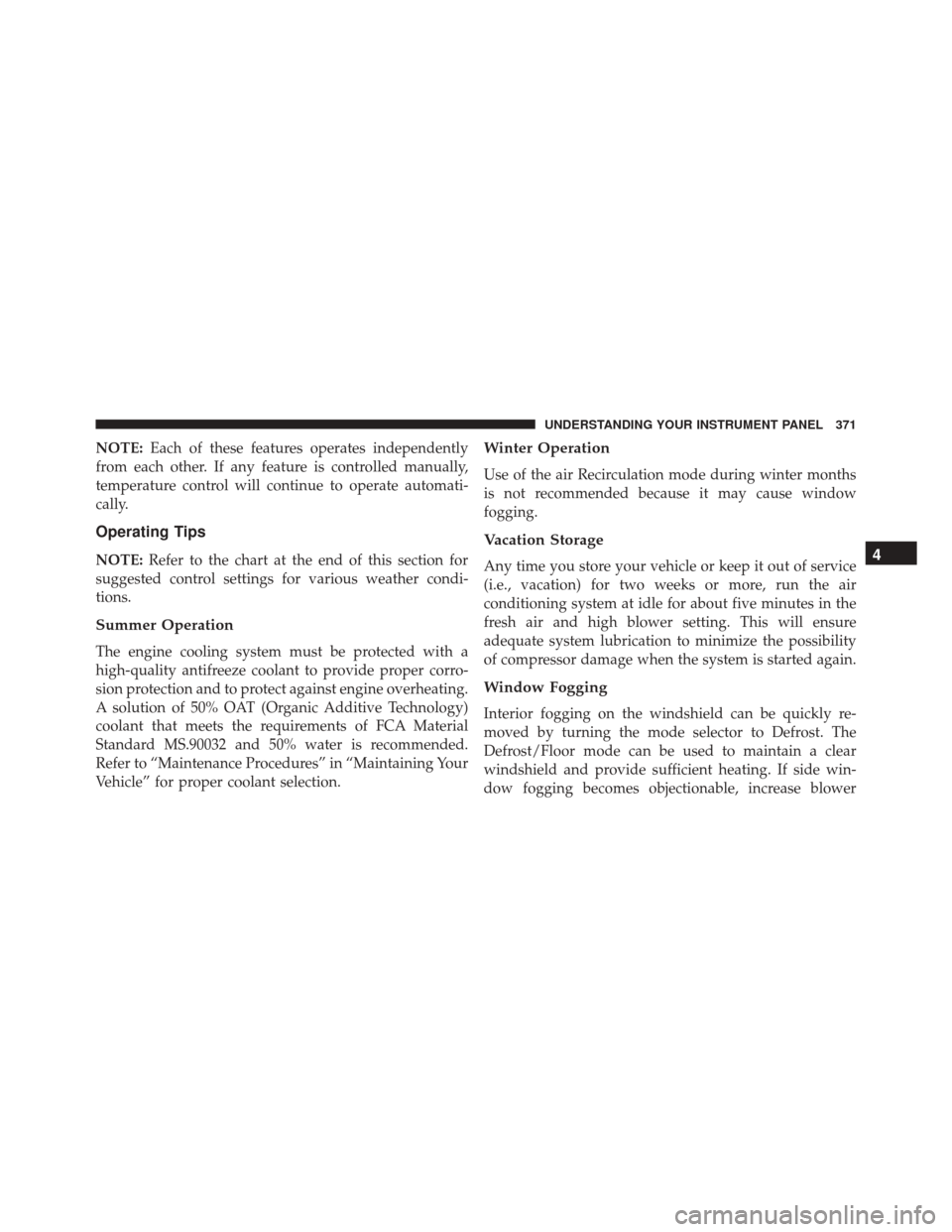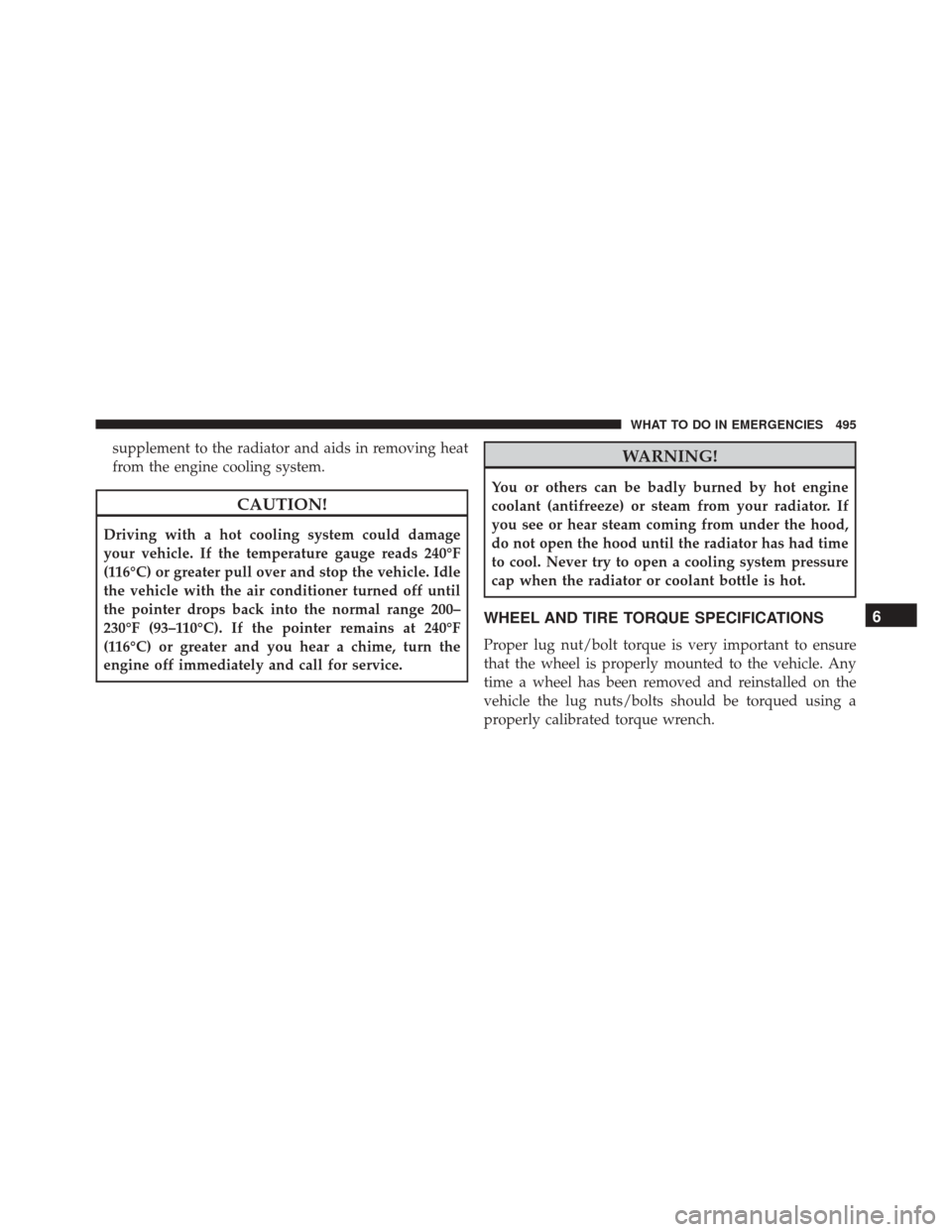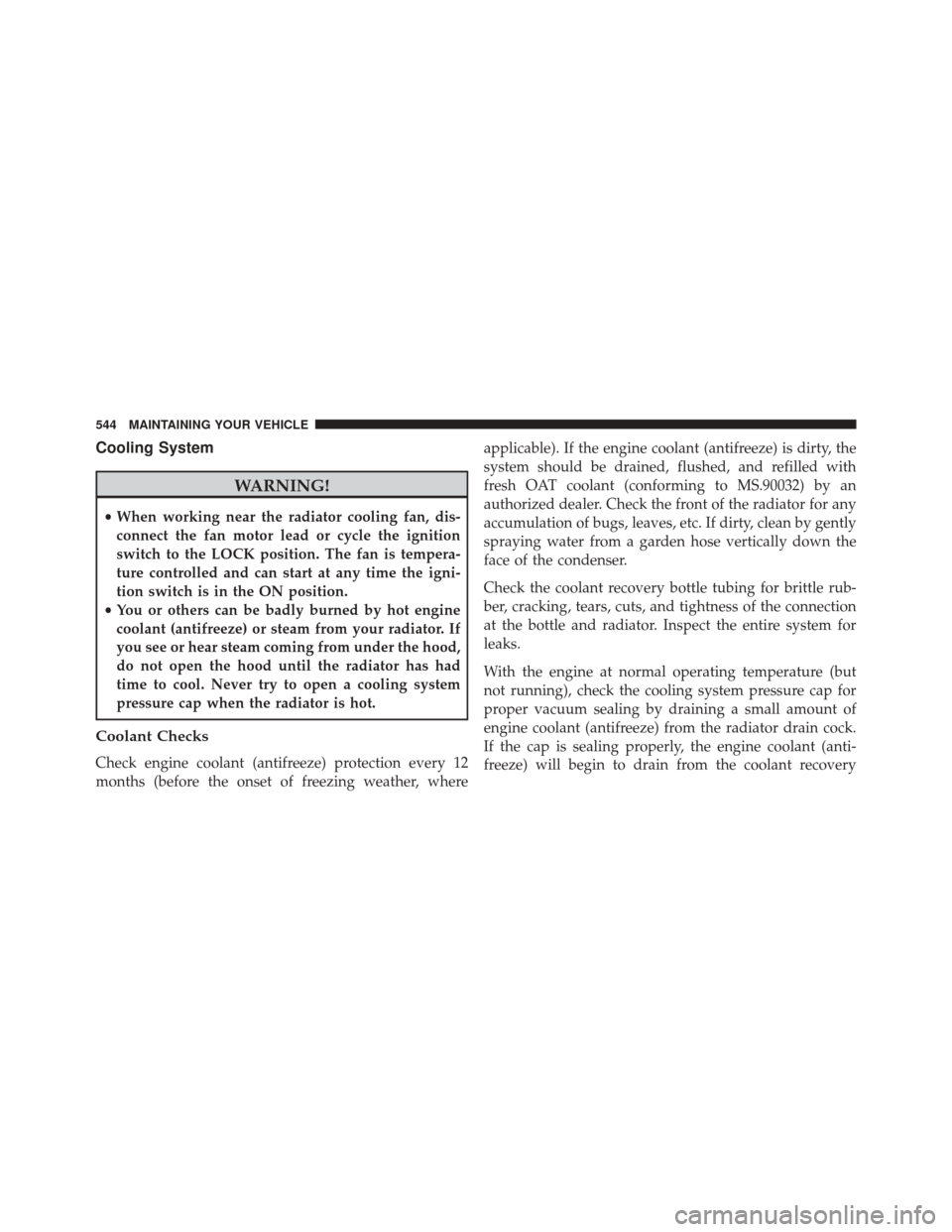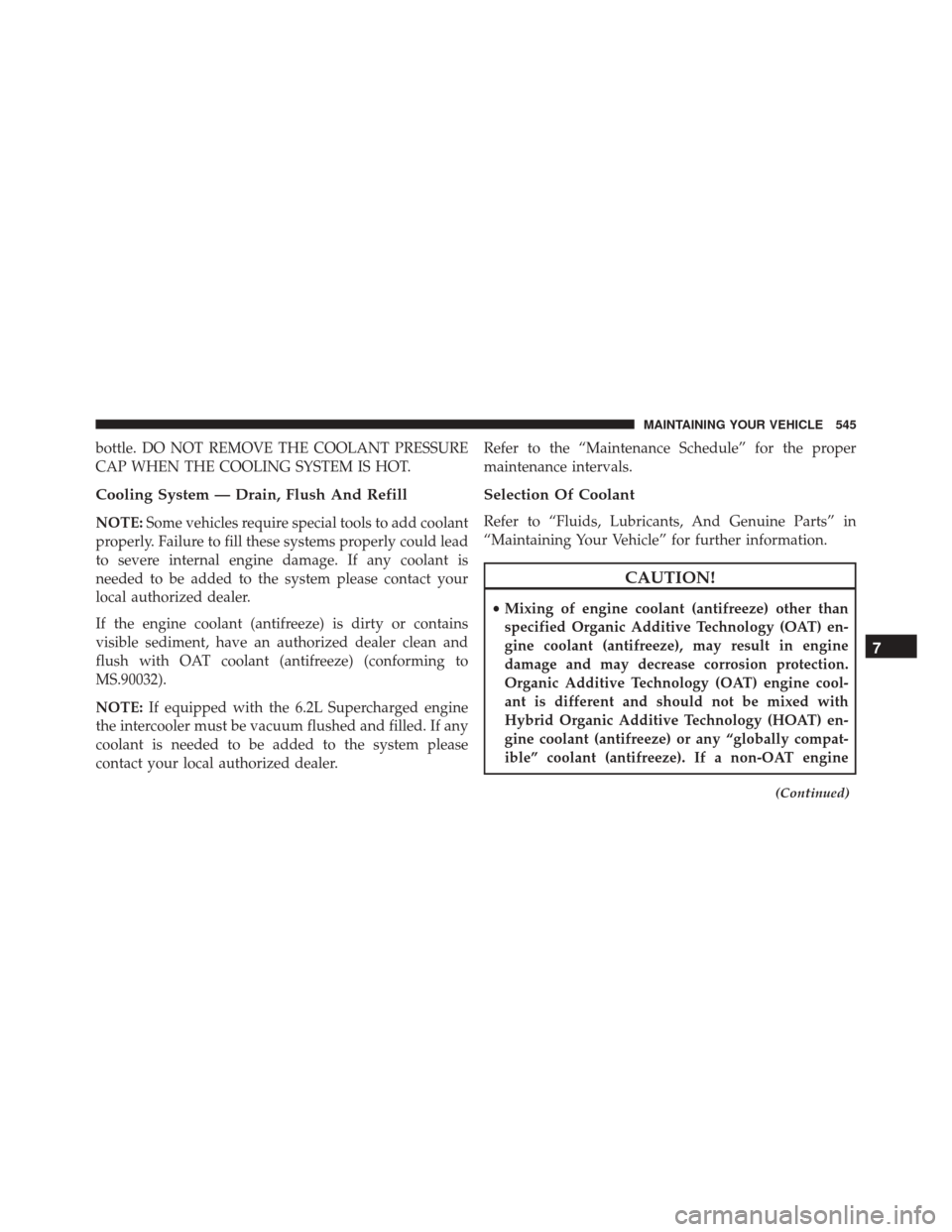Page 334 of 634
When selected, this screen displays the following values:
•Coolant Temperature
Shows the actual coolant temperature.
• Oil Temperature
Shows the actual oil temperature.
• Oil Pressure
Shows the actual oil pressure.Gauges 2
When selected, this screen displays the following values:
• Battery Voltage
Shows the actual battery voltage.
SRT Performance Pages — Gauges 2 (6.4L)
332 UNDERSTANDING YOUR INSTRUMENT PANEL
Page 335 of 634
•Intake Air Temperature
Shows the actual intake air temperature.
• Transmission Temperature
Shows the actual transmission temperature. When selected, this screen displays the following values:
•
Boost Pressure
Shows the current value for boost pressure.
• Air Fuel Ratio
Shows the current value for the air fuel ratio.
• Inter-Cooler (I/C) Coolant Temperature
Shows the current value for the I/C coolant temperature.
• Intake Air Temperature
Shows the actual intake air temperature.
SRT Performance Pages — Gauges 2 (6.2L)
4
UNDERSTANDING YOUR INSTRUMENT PANEL 333
Page 373 of 634

NOTE:Each of these features operates independently
from each other. If any feature is controlled manually,
temperature control will continue to operate automati-
cally.
Operating Tips
NOTE: Refer to the chart at the end of this section for
suggested control settings for various weather condi-
tions.
Summer Operation
The engine cooling system must be protected with a
high-quality antifreeze coolant to provide proper corro-
sion protection and to protect against engine overheating.
A solution of 50% OAT (Organic Additive Technology)
coolant that meets the requirements of FCA Material
Standard MS.90032 and 50% water is recommended.
Refer to “Maintenance Procedures” in “Maintaining Your
Vehicle” for proper coolant selection.
Winter Operation
Use of the air Recirculation mode during winter months
is not recommended because it may cause window
fogging.
Vacation Storage
Any time you store your vehicle or keep it out of service
(i.e., vacation) for two weeks or more, run the air
conditioning system at idle for about five minutes in the
fresh air and high blower setting. This will ensure
adequate system lubrication to minimize the possibility
of compressor damage when the system is started again.
Window Fogging
Interior fogging on the windshield can be quickly re-
moved by turning the mode selector to Defrost. The
Defrost/Floor mode can be used to maintain a clear
windshield and provide sufficient heating. If side win-
dow fogging becomes objectionable, increase blower
4
UNDERSTANDING YOUR INSTRUMENT PANEL 371
Page 497 of 634

supplement to the radiator and aids in removing heat
from the engine cooling system.
CAUTION!
Driving with a hot cooling system could damage
your vehicle. If the temperature gauge reads 240°F
(116°C) or greater pull over and stop the vehicle. Idle
the vehicle with the air conditioner turned off until
the pointer drops back into the normal range 200–
230°F (93–110°C). If the pointer remains at 240°F
(116°C) or greater and you hear a chime, turn the
engine off immediately and call for service.
WARNING!
You or others can be badly burned by hot engine
coolant (antifreeze) or steam from your radiator. If
you see or hear steam coming from under the hood,
do not open the hood until the radiator has had time
to cool. Never try to open a cooling system pressure
cap when the radiator or coolant bottle is hot.
WHEEL AND TIRE TORQUE SPECIFICATIONS
Proper lug nut/bolt torque is very important to ensure
that the wheel is properly mounted to the vehicle. Any
time a wheel has been removed and reinstalled on the
vehicle the lug nuts/bolts should be torqued using a
properly calibrated torque wrench.
6
WHAT TO DO IN EMERGENCIES 495
Page 526 of 634
ENGINE COMPARTMENT — 6.2L SUPERCHARGED
1 — Remote Jump Start (Positive Battery Post)7 — Engine Coolant Reservoir
2 — Remote Jump Start (Negative Battery Post) 8 — Air Cleaner Filter
3 — Intercooler Fluid Reservoir 9 — Power Steering Reservoir
4 — Engine Oil Fill 10 — Engine Oil Dipstick
5 — Engine Coolant Pressure Cap 11 — Power Distribution Center (Fuses)
6 — Brake Fluid Reservoir Access Cover 12— Washer Fluid Reservoir
524 MAINTAINING YOUR VEHICLE
Page 527 of 634
ENGINE COMPARTMENT — 6.4L (392 HEMI)
1 — Remote Jump Start (Positive Battery Post)6 — Engine Coolant Pressure Cap
2 — Remote Jump Start (Negative Battery Post) 7 — Engine Coolant Reservoir
3 — Engine Oil Dipstick 8 — Air Cleaner Filter
4 — Engine Oil Fill 9 — Power Distribution Center (Fuses)
5 — Brake Fluid Reservoir 10 — Washer Fluid Reservoir
7
MAINTAINING YOUR VEHICLE 525
Page 546 of 634

Cooling System
WARNING!
•When working near the radiator cooling fan, dis-
connect the fan motor lead or cycle the ignition
switch to the LOCK position. The fan is tempera-
ture controlled and can start at any time the igni-
tion switch is in the ON position.
• You or others can be badly burned by hot engine
coolant (antifreeze) or steam from your radiator. If
you see or hear steam coming from under the hood,
do not open the hood until the radiator has had
time to cool. Never try to open a cooling system
pressure cap when the radiator is hot.
Coolant Checks
Check engine coolant (antifreeze) protection every 12
months (before the onset of freezing weather, where applicable). If the engine coolant (antifreeze) is dirty, the
system should be drained, flushed, and refilled with
fresh OAT coolant (conforming to MS.90032) by an
authorized dealer. Check the front of the radiator for any
accumulation of bugs, leaves, etc. If dirty, clean by gently
spraying water from a garden hose vertically down the
face of the condenser.
Check the coolant recovery bottle tubing for brittle rub-
ber, cracking, tears, cuts, and tightness of the connection
at the bottle and radiator. Inspect the entire system for
leaks.
With the engine at normal operating temperature (but
not running), check the cooling system pressure cap for
proper vacuum sealing by draining a small amount of
engine coolant (antifreeze) from the radiator drain cock.
If the cap is sealing properly, the engine coolant (anti-
freeze) will begin to drain from the coolant recovery
544 MAINTAINING YOUR VEHICLE
Page 547 of 634

bottle. DO NOT REMOVE THE COOLANT PRESSURE
CAP WHEN THE COOLING SYSTEM IS HOT.
Cooling System — Drain, Flush And Refill
NOTE:Some vehicles require special tools to add coolant
properly. Failure to fill these systems properly could lead
to severe internal engine damage. If any coolant is
needed to be added to the system please contact your
local authorized dealer.
If the engine coolant (antifreeze) is dirty or contains
visible sediment, have an authorized dealer clean and
flush with OAT coolant (antifreeze) (conforming to
MS.90032).
NOTE: If equipped with the 6.2L Supercharged engine
the intercooler must be vacuum flushed and filled. If any
coolant is needed to be added to the system please
contact your local authorized dealer. Refer to the “Maintenance Schedule” for the proper
maintenance intervals.
Selection Of Coolant
Refer to “Fluids, Lubricants, And Genuine Parts” in
“Maintaining Your Vehicle” for further information.
CAUTION!
•
Mixing of engine coolant (antifreeze) other than
specified Organic Additive Technology (OAT) en-
gine coolant (antifreeze), may result in engine
damage and may decrease corrosion protection.
Organic Additive Technology (OAT) engine cool-
ant is different and should not be mixed with
Hybrid Organic Additive Technology (HOAT) en-
gine coolant (antifreeze) or any “globally compat-
ible” coolant (antifreeze). If a non-OAT engine
(Continued)
7
MAINTAINING YOUR VEHICLE 545